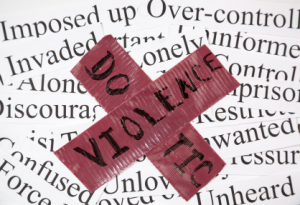>> Domestic violence can’t be summed up in a two-hour Lifetime movie. You can’t package it in a neat little bow. If you haven’t lived it, it’s easy to question the victim – why he or she stayed in the relationship – and assume that getting out of the situation is as simple as leaving. In the movies, the situation is always resolved, the “victim” (I really hate that term) is victorious, and oh — by the way –likely met the love of his/her life in the process.
Domestic violence can’t be summed up in a two-hour Lifetime movie. You can’t package it in a neat little bow. If you haven’t lived it, it’s easy to question the victim – why he or she stayed in the relationship – and assume that getting out of the situation is as simple as leaving. In the movies, the situation is always resolved, the “victim” (I really hate that term) is victorious, and oh — by the way –likely met the love of his/her life in the process.
I’m here to tell you it’s not that simple. I’ve witnessed physical and emotional abuse in my life. I had a friend in high school that experienced it – and as close as we were, I didn’t know about the abuse until years later.
This month Women AdvaNCe is focusing on the issue of Domestic Violence and expanding on the issues surrounding it – such as mental health, breaking the cycle, and what socioeconomic trends trigger it to occur.
On average, nearly >>20 people per minute are victims of physical violence by an intimate partner in the U.S. Beyond that, many more experience emotional abuse. Based on what I’ve heard in conversation with other women, and learned through research, often people don’t realize they’re in an abusive situation until their ties to their abuser are so strong, they’re tough to break.
What is domestic violence?
Domestic violence is the willful intimidation, physical assault, battery, sexual assault, and/or other abusive behavior as part of a systematic pattern of power and control perpetrated by one intimate partner against another. It includes physical violence, sexual violence, threats, and emotional abuse. The frequency and severity of domestic violence can vary dramatically.
According to the Council for Women, domestic violence centers in North Carolina received more than 114,000 calls in 2012-2013, and had more than 57,000 clients. When you consider the state’s population of 9.7 million people, that means that just a little over 1% of them placed a call for help. When you take into account data that shows that one in three women and one in four men have experienced some type of physical violence in their lifetime, it’s safe to assume that there are thousands of people who never place that call for help.
For some, that results in death. According to the>> North Carolina Department of Justice, there were 108 homicides related to domestic violence in 2013, two more than the year before.
It comes down to local organizations and municipalities having the resources to offer help to the abused and the abusers. Last month Pitt County received a $400,000 grant from the U.S. Justice Department to double the amount of trained specialists and will also train police officers to ask specific questions to determine a person’s future risk of another domestic violence incident. The county is one of four in the country to receive the funding.
North Carolina’s funding for domestic violence programs has remained consistent for the last two years, but there are other budget cuts impacting the population, including cuts to legal aid groups in the state. Their funding was cut by 54-percent in 2013. Additionally, as of yesterday (September 30th) funding for “displace homemakers” expired, and was not renewed by the General Assembly. That funding provided help to women and men to get back on their feet after leaving an abusive relationship.
There was also an attempt to further protect people at risk for domestic violence. House Bill 477, Allison’s Law, would allow a domestic violence protective order to include a provision that a defendant the court finds has committed an act of domestic violence be subject to electronic monitoring by a GPS tracking device. The bill was referred to committee and hasn’t made any progress since then.
Clearly, there is more work to be done, because one more death related to domestic abuse is too many, and for the thousands living in abusive relationships every additional day is too much to take.
Click here for a list of domestic violence service providers in the state. You can also call 1-800-799-SAFE for help.
There are no comments
Add yours